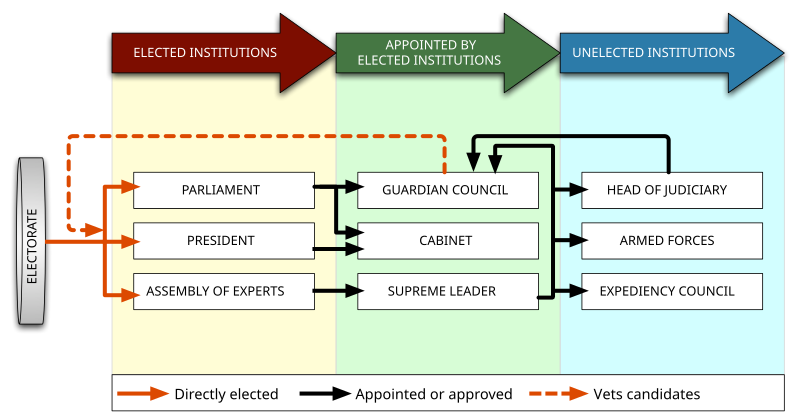Trope's Truth Corner: Iran's Political Structure - The Bigger Picture
Supreme Leader:
The Supreme Leader is the most powerful person in Iran. He is elected indirectly by the Assembly of Experts (who are elected every eight years by the General Electorate). The Assembly of Experts also have the power to dismiss the Supreme Leader, although this has never been done in the thirty years since the Islamic Revolution when the current system was implemented. There is no term length for the Supreme Leader, giving them immense leverage and immunity from public opinion. There have only been two Supreme Leaders since the Revolution in 1978, with the current one being Ali Khamenei, in power since 1989.
Powers of the Supreme Leader include the ability to appoint the Head of the Judiciary, the Commander of the Armed Forces, and the Expediency Discernment Council. Furthermore, he also gets to choose the director of the National Television and Radio network, the head of major religious foundations, the prayer leaders in city mosques, and members of national security councils. Perhaps most importantly, the Supreme Leader also gets to appoint six of the twelve members of the all-important Guardian Council (the other six are elected by the Parliament from a list of candidates nominated by the Head of the Judiciary, who, you guessed it, the Supreme Leader also gets to appoint).
Guardian Council:
The Guardian Council Consists of 12 members, 6 of whom are elected directly by the Supreme Leader (generally clerics) and 6 who are elected by the Parliament off of a list of candidates nominated by the Head of the Judiciary. The Guardian Council gets to decide when a bill passed by the Parliament is unconstitutional using a process similar to judicial review in the E.U. The Council also has a special power and influence over elections unprecedented in most democracies for an un-elected bunch-all potential candidates who wish to run for either President or Parliament must be approved to run by the Guardian Council.
Head of Judiciary:
The Head of the Judiciary is elected directly by the Supreme Leader. He is the head of the judicial branch in Iran, as he gets to appoint the head of the Supreme Court as well as the Chief Prosecutor. Furthermore, the Head of the Judiciary gets to nominate candidates to fill six of the seats in the all-important Guardian Council (which the Parliament then chooses from and elects).
Parliament (also called Majiles):
The Majiles are directly elected by the General Electorate, although the Guardian Council must first approve all potential candidates. Parliament consists of 290 members who are elected to four-year terms (with the last election having been in 2008). All Majiles run in single member districts using a warped version of a majority system where instead of candidates needing to get over 50% of the vote to win and avoid a runoff, in Iran the candidate with the most votes needs only 25%. Even with such a low threshold, in 2008, of the 290 races there were 82 that went to a runoff.
The main responsibilities of the Majiles are comparable to most legislatures as they draft legislation, ratify treaties, and approve the national budget. Individual members also can propose new agendas and legislation, although the president normally does that.
President:
The President of Iran is elected every four years by the general electorate using a majority system (winner must receive 50% of the vote or there is a runoff). Currently Mahmoud Ahmadinejad holds this position and won reelection earlier this week, although the results are highly dubious and many – if not most – believe them to be fraudulent (see my colleague Allison Meyer's blog post on the aftermath of the election). The Guardian Council must approve all candidates who wish to run for the presidency. This gives the Supreme Leader great control over who gets to run for President since half of the Council is elected by him (and the other half is nominated by the Head of the Judiciary, who is appointed by him). Similarly to the U.S., the President of Iran can only serve two terms consecutively.
The President of Iran is the second most prestigious and important position in Iran following the Supreme Leader. The President is supposed to uphold the Constitution and is the head of the executive branch for all matters that are not directly related to the Supreme Leader. It is the president's responsibility to propose laws, sign international treaties, draft the national budget, etc. The president also appoints members of his cabinet as well as vice presidents (currently there are 10 vice presidents); all of them must be approved by the Parliament, however.

